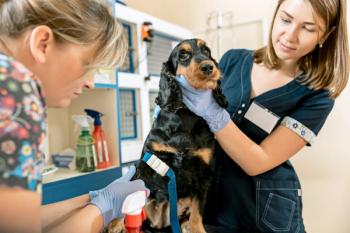
AVMA workforce study identifies 12.5 percent excess capacity in veterinary services
Veterinary Workforce Simulation Model introduced to gather key data to better understand profession and its economic woes.
The American Veterinary Medical Association (AVMA) 2013 Veterinary Workforce Report estimates an excess capacity of veterinary services at 12.5 percent. Released Tuesday, April 23, the survey, conducted by IHS Healthcare & Pharma in partnership with the State University of New York in Albany, also indicates that supply will continue to outpace demand into the foreseeable future if current conditions in the profession don’t change.
Specifically, the report indicates that the supply of veterinarians in the United States in 2012 was 90,200 and that supply exceeded demand for veterinary services by about 11,250 full-time equivalent veterinarians. However, study directors emphasize, this does not mean there is an oversupply of veterinarians, or 11,250 veterinarians too many. A true oversupply in economic terms, they say, would be reflected in a high level of unemployment, and unemployment in the veterinary profession at just 2 percent is quite low. Rather, the study reports, 12.5 percent of veterinarians’ capacity to provide services is going unused.
Present for a telephone press conference to discuss the report Tuesday were Michael Dicks, PhD, director of the AVMA Veterinary Economics Division; Link Welborn, DVM, chairman of the AVMA Workforce Advisory Group; and Douglas Aspros, DVM, AVMA president. The bottom line? The AVMA is working to develop strategies to address economic problems and increase demand for veterinary services. The recently established Veterinary Economics Division of the AVMA is tasked with that mission.
The AVMA hopes the profession will better understand itself economically by sourcing more and previously lacking data in order to combat problems such as excess capacity. The new Veterinary Workforce Simulation Model is designed to aid in that. “As we come up with strategies to reduce the excess capacity in the industry, this model will be able to tell us if we are succeeding or not,” Aspros says. The model is an AVMA-owned, proprietary software program that will gather information pertaining to the supply and demand for veterinarians and veterinary services, as well as overall veterinary economics.
The AVMA hopes to gain statistics on those entering and exiting the U.S. veterinary workforce, find information on why female veterinarians are earning less, and even determine how much excess capacity is good for the profession. “We don’t know what the optimal level of excess capacity is,” Aspros says. Lowering the excess capacity of the average veterinarian could become a negative if a client called for an appointment and couldn’t be seen right away.
The group assembled for the press conference says despite the questions that remain and the gaps in data, the problem is excess capacity, not an overabundance of veterinarians in the workforce. “It’s more complicated than saying there are too many or too few veterinarians—it’s not that simple,” Wellborn says.
They contend it is weak demand, not an overabundance of supply that is the problem. “I don’t think you want to say we have too many veterinarians. It’s a matter of veterinarians not running their practice at full capacity,” Dicks says. “Incomes are falling and veterinarians don’t feel like they’re working full time.”
The AVMA hopes that identifying factors that precipitate excess capacity will become clearer as data is analyzed over time with the Veterinary Workforce Simulation Model. Aspros says the one thing that is clear from the snapshot the study provided of the profession is that “without anything changing, the situation is going to get worse.”
Veterinary salaries are going down; student debt is going up. The study estimates the future supply of full time veterinarians under the status quo will raise from 90,200 in 2012 to 108,900 by 2030. This took into account the projected annual growth rate of new entrants into the profession to be 2 percent—up to 4 percent when factoring in international entrants.
“While there’s no question that the profession has challenges today, we don’t want to scare off the best and the brightest,” Dicks says regarding the study and the present state of the profession on current or prospective veterinary students. In contrast, he says, unemployment for veterinarians is quite low.
“As a profession we need to respond to those [challenges], but we shouldn’t take it as the sky is falling—it’s not,” Aspros says.
He says the positive from this study is that while most agree the profession is facing a lot of negatives, it is willing to provide data to address problems. “We are in this together,” Aspros says. “This is a pretty diverse profession. The concern that I have as a small animal practitioner is not necessarily happening in a vacuum. There is just concern about where we’re going and that’s a good thing, a necessary thing.”
To view the 2013 AVMA Workforce study, go to avma.org.
Newsletter
From exam room tips to practice management insights, get trusted veterinary news delivered straight to your inbox—subscribe to dvm360.




